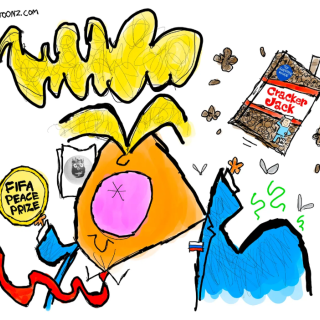Advertisement
"Chevalier" is the story of composer Joseph Bologne, Chevalier de Saint-Georges (Kelvin Harrison Jr.) The illegitimate son of an African slave and a French plantation owner, Bologne rises to improbable heights in French society as a celebrated violinist-composer and fencer, complete with an ill-fated love affair and a falling out with Marie Antoinette (Lucy Boynton) herself and her court.
As a man of mixed race, Joseph Bologne is, during his time, undeniably shackled by French laws and by social conventions. He comes to defy the aristocracy he once moved within and is changed by a love made impossible by his race. And he rediscovered his heritage, bringing Creole influences to his music and fighting for his people. And yet, is remarkable virtuosity and persona allowed him to enter, however precariously, the circle of elites enjoying wealth, power, and the outrageous excesses of the age.
Though forbidden to marry in France, Bologne is said to have been pursued by many adoring women. Joseph has a bit of cheekiness with his long lashes, eyeliner, and beauty mark. He’s elegant but also edgy and a little androgynous. Few details are known of his private romantic life, but he's believed to have been especially close with Marie-Josephine de Comarieu (Samara Weaving), wife of the Marquise de Montalembert (Martin Csokas).
In the film, Marie-Josephine is a singer longing for an escape from a loveless marriage when Joseph casts her in his opera, sparking a star-crossed love affair. She symbolizes all that seems off-limits to Joseph. He thinks she's all that he wants, but she's really part of his journey to finding what really brings him happiness.
Despite his marginal status, Bologne’s brilliance is such that he's recruited to teach music to the most powerful teenager in the world, the iconic Marie Antoinette (Lucy Boynton), the Austrian princess who would become the very last Queen of France, spurring the French Revolution, during which she would be guillotined. Arriving in France at the tender age of 14, Antoinette would eventually be maligned by history as the ultimate symbol of detached privilege and elitist hypocrisy. And yet, a more complicated view of her has emerged recently: that of an incredibly young, poorly prepared, if extravagantly spendthrift, girl tragically thrust into leading a country about to explode from extreme social inequality.
As with Bologne’s other relationships, only the broad outlines of his interactions with Marie Antoinette are known. But one thing that was clear is that when Marie Antoinette could have used her power to aid Bologne, she instead allowed dreams to be crushed. So long as Joseph is just a fun play companion, Marie Antoinette is very content to indulge their relationship. But when she's required to stand up for Joseph, she didn't. In the film, that betrayal becomes the catalyst to Joseph envisioning a different kind of life for himself and for France. And that’s when she's able to retreat into her privilege. Marie Antoinette and Joseph, while it lasts, they’re each, in their own way, trying to find belonging in this chaotic world.
The aristocratic diva Marie-Madeleine Guimard (Minnie Driver) is the toast of France under Louis XVI, a courtesan renowned for her extensive love life, and an influential member of Marie Antoinette’s inner circle. The film picks up on rumors that Guimard might have pursued Bologne romantically, but when he rejected her, she turned against him, leading a racist campaign to keep him from heading the Paris Opera. She illustrates how all of Joseph’s grace, talent, and amazing energy are enjoyed but ultimately don’t matter because he’s a man of color in the French court.
Leading a life at the opposite end of the spectrum from Marie Antoinette’s overwhelming power is Joseph’s mother, Nanon (Ronkẹ Adékoluẹjo). Although Joseph’s mother is brought to Paris when he was 12 or 13 to live as a free woman, in the film, she reunites with a grown-up Joseph after having been separated from him for years. She becomes Joseph’s conscience in a way as she helps him find a truer connection to the totality of whom he's. It’s devastating to think about all these people who couldn’t live how they wanted.
Joseph Bologne, Chevalier de Saint-Georges was born in 1745 on the island of Guadeloupe to a wealthy French plantation owner and his 16-year-old slave from Senegal, known as Nanon. His father sent him as a child to Paris and then to the famed La Boëssière Academy to study music, math, literature, and fencing, all necessary in Enlightenment France. Joseph not only excelled in these, he triumphed. As he came of age, his many skills multiplied and advanced. He became legendary as Europe’s most undefeated fencer and lauded as a dancer, equestrian and fashion trendsetter. Soon, people flocked to his violin concerts as he gained a reputation for pushing the instrument to its limits.
He went even further as a composer, writing some of the world’s first, pioneering string quartets and helping to establish the rich symmetry and melody of the Baroque era. Complex and emotional, his work influenced other composers, including, many scholars suggest, his contemporary, Wolfgang Amadeus Mozart. He was made an officer of the King’s Guard and dubbed Chevalier de Saint-Georges in 1762. Yet, even while leading a life of creative opportunity in Paris, Bologne was not afforded the same rights as others and was subjected to limits on his freedom and, at times, to outright hatred. While France’s Enlightenment philosophers opposed slavery, Bologne was well aware that the monarchy supported it. On the cusp of becoming the first person of color to head the Paris Opera, way ahead of his time, a trio of divas intervened, declaring they would never submit to orders of a mulatto.
Set in 18th century France, "Chevalier" unfolds the vivid story of the soaring rise and defiant spirit of the musical phenomenon, Joseph Bologne, aka the Chevalier de Saint-Georges. The Chevalier was what we would call today a superstar, a blinding multi-talent at the top of several games: he was a virtuoso violinist who gave packed concerts; a champion swordsman; an ingenious composer; and, for a time, one of the most alluring, unexpected members of Marie Antoinette’s glittering court. With his papers and his music destroyed in Napoleonic times, little is known of his inner experiences moving in the sphere of the elites.
With many of the details of the period, the film is a buoyant and aspiring vision of a man driven to create and to truly be who he was, no matter the expectations put upon him, or the dreams forbidden to those like him. From its high-voltage opening violin battle, the film lends Bologne a touch of rock-and-roll swagger. But if Bologne’s fame and radiance echo the world of the modern pop star, his tale is equally an exploration of something very relatable today: how a person breaks out from the trap of what others expect or demand. It's an astonishing accolade for someone born in the Caribbean under the Code Noir, the French legal document that diminished and controlled every aspect of the lives of people of color, from whom they could marry, to what religion they could follow, to which punishments they would endure.
A pressure he knows well, the mindset that you must be ten times better than your peers, and above reproach, just to be valued. You see Joseph start out believing that if he can just excel at everything he does, he’ll be accepted into aristocratic society. But what he discovers is that social acceptance is not what counts. It's self-acceptance that's most important in a life journey. We've to understand him as a Black artist. His path reflects how we all struggle to find the spaces where we can be seen and heard. This story asks big questions about art and equality and why so many Black artists have been erased, but it’s also a beautiful celebration of the Chevalier’s life. The French Revolution is so reminiscent of the social convulsions we’ve seen globally over the last few years, with similar outcries for equality and greater accountability. It’s a world that mirrors our own.
Few eras in history have dripped with more money, elegance, and preening privilege than Marie Antoinette’s France. While the era of the Ancien Régime has been explored before in painstaking detail. The entire conceit of the movie’s design revolved around finding the exact fulcrum between period credibility and a vital sense of modernity. The contemporary feeling in the film is all about the camera, the acting, and the language. The film fills it with gold and pastels, with flowers, candles, fruits, and cake displays. It contrasts with the grittier streets of Paris, showing how much society was divided as unrest was building. The clothing of the social elite is just as luxurious, bursting with candy-colored pastels and textured fabrics of silk, organza, feathers, and lace. Blue is actually one of the most popular colors of the time, symbolic of elegance and sophistication. In the late 1700s, makeup is used equally, and heavily, by both men and women. The film brings to audiences also the real sounds of Joseph Bologne, Chevalier de Saint-Georges (1745-1799), music which has only in recent years started to be played again to great acclaim by orchestras and opera houses worldwide. More than 200 years later, the triumph of the Chevalier’s life, for so long erased, finally has a chance to be historically recognized. It's a moment from which we can’t go back, but it's equally a moment of self-discovery.
OPENS ON APRIL 21 AT
AMC COLUMBUS 10
AMC DUBLIN VILLAGE 18
AMC GROOVE CITY 14
AMC DINE-IN EASTERN TOWN CENTER 30
https://www.amctheatres.com/movie-theatres/columbus/amc-columbus-10/show...
GATEWAY FILM CENTER
https://gatewayfilmcenter.org/movies/chevalier-2023/









